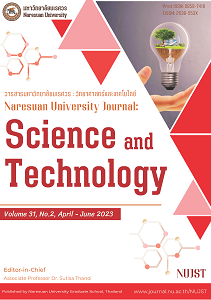The Construction of an Application to Manage Health Problems of Ethnic Groups in Chiang Dao District to Reduce Social Inequality in Access to Essential Services in Public Health
DOI:
https://doi.org/10.14456/nujst.2023.17Keywords:
Inequality, Ethnic Groups, Technology, Public Health, Mobile ApplicationAbstract
Public health inequality has played a significant role in Thai society, especially among the ethnic groups who are regarded as vulnerable. They have encountered problems accessing public health services in Chiang Dao district, Chiang Mai province, due to communication and distance problems causing higher mortality rates than in low-lying areas. The objective of this research was to create an application to facilitate preliminary healthcare services and treatment of the ethnic groups in an attempt to reduce social inequality in accessing basic healthcare services of the ethnic groups. The research process involved eight steps. The first step was concerned with examining frequently discovered illnesses and ailments among the ethnic group in the study area from Chiang Dao hospital and its public health network as well as from documentary research and in-depth interviews. The second step was fieldwork with community participation to investigate actual healthcare problems in the study areas. The third step was concerned with collecting, analyzing and synthesizing the collected data. The fourth step dealt with preliminary treatments of illnesses and ailments, submission of the data to medical personnel for verifying the correctness of the data, and classification of basic treatment methods according to types of illnesses. The fifth step involved fieldwork to collect four ethnic languages, which included Akha, Karen, Hmong, and Lisu. The sixth step was about the design and construction of the application. The seventh step was to test the operation of the application with 150 ethnic individuals before carrying out the improvement. The last step was about the formation of the application manual.
The application for preliminary healthcare and illness treatment for the participating ethnic groups was constructed based on the Flutter software development kit and the Dart programming language and operates on the android operation system on mobile phones. The application was tried and used by 150 ethnic respondents for preliminary healthcare and illness treatment. A questionnaire was then administered to find out the satisfaction of the application users. The overall mean efficiency of the application is at a high level (Mean = 4.24, S.D. = 0.53). To construct this healthcare application for the ethnic groups is another channel for them to better access public health services in the district as generally impeded by linguistic and distance problems. This is a form of healthcare system development in the country, which could be a solid foundation for overall national development and a part of the Sustainable Development Goals.
References
Achananuphap, S. (2008). General Diagnosis and Treatment. Bangkok: Holistic Publishing.
Arunsirot, N., & Chaichompoo, C. (2019). Integrating English with Content in Teaching Cultural Tourism Management to Secondary School Students in Amphur Chiang Dao, Chiangmai. Journal of Language, Religion and Culture, 8(1), 29-51.
Boonchum, V., Khamdam, K., & Khruathong, R. (2020). The development of an android application for disseminating Thai cultural heritage of the lower southern provinces of Thailand. Thaksin University Journal, 23, 31-40.
Creighton, J. L. (2005). The public participation handbook: Making better decisions through citizen involvement. San Francisco: Jossey-Bass.
Khamsuwan, S. (2019). A study of the effectiveness of the online infographic poster media of the social security office. UMT Poly Journal, 16, 131-136.
Mahatthanachai, C., & Mahatthanachai, B. (2022). A Healthcare Digital Technology System for Non-Communicable Disease Surveillance. The Journal of Science and Technology, 6(2), 63-76.
Ministry of Social Development and Human Security. (2023). Strategic plan of Ministry of Social Development and Human Security in 2023-2027. Bangkok: Ministry of Social Development and Human Security.
Moonpanane, K., & Thepsaw, J. (2019). Health Security of Ethnics Pre-School Children: A Challenge to Nursing Roles. Journal of Nursing Science Chulalongkorn University, 31(2), 1-9.
Phokhaisawan, C., Ingkhamrathorn, S., & Suthiphong, R. (2018). The diversity of using languages, national conference. The 6th Chombueng Rajabhat’s Acedemic National Conference (pp. 1379-1387). Ratchaburi: Chombueng Rajabhat University.
Prommarak, C., & Rittikoop, W. (2021). The Development of Learning Management Based on the Multilingual Concept Using the Mother Tongue with Task-Based Language Teaching to Strengthen English Listening and Speaking Skills for Lahu Tribe Students in Grade 3. Journal of Graduate Research, 12(2), 45-60.
Ramdurai, B. (2021). A study on mobile apps in the healthcare industry. International Journal of Mobile Computing and Application, 8(1), 17-21.
Trithosadet, D. (2018). The construction of two-dimension infographic for the learning of the hip hop cultural evoluation. Pathumthani: Rangsit University.
Winslow, C. E. A. (1920). The Untilled Fields of Publish Health. Science, 51, 23-33.
Downloads
Published
Issue
Section
License
Copyright (c) 2023 Naresuan University Journal: Science and Technology (NUJST)

This work is licensed under a Creative Commons Attribution-NonCommercial 4.0 International License.













